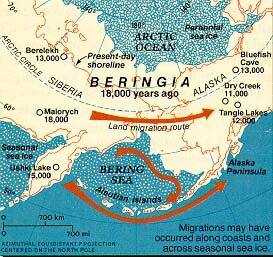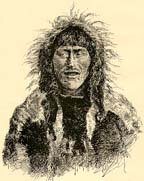

The history of human beings on this planet is a short one by geologic standards. Yet it covers many millions of years. In trying to understand this development, we can call upon five to ten thousand years of quite satisfactory records which then trail off into the silence of the hunter's and gatherer's Stone Age world. The rest of this time has left no legend on human tongues and an extremely sparse record in the soil. Of the momentous transformations occurring then, all that remain are a few broken skulls, teeth, bones, and a scattering of simple tools - not much help in our search to comprehend this long journey of the past. Furthermore, unless we listen carefully, even these simple tools tell us false stories; for they are but fragments of a much larger collection, the other items of which have not been preserved. Beyond recall are tote bags nursing mothers invented to carry their infants while foraging for food, tinder designed for starting fires, or thoughts of ancient parents leaning over a fevered child.
Still, archeologists have much to offer in interpreting these fragments of the human adventure. And we can utilize as well one of their guiding principles, cultural ecology and its corollary, adaptation. Without such a principle, these prehistoric detectives would simply be presenting us with a conglomeration of unrelated facts. With such a clarifying paradigm, we gain contextual meaning - an essential feature of any serious inquiry. This approach is especially germane to studies of the Circumpolar North, for as every North American school-age child knows, the Arctic has always served as a natural laboratory, testing the northerner's ability to survive in a severe environment.
Given these environmental limitations, present day Inuit have met this challenge with ingenuity and skill. Yet they followed long after the first inhabitants of the region. These earlier humans entered the New World by way of Beringia, an intercontinental land 'bridge' half the width of the United States connecting the region of Bering Strait with Siberia. We know little of human antiquity in this northern sector of the Old World, although archeological remains from the Lake Baikal region of the Trans-Baikal date as far back as 13,000 to 25,000 years ago.

The residents of the Russian steppe-tundra were not northern remnants of Ice Age Neanderthals, but contemporary homo sapiens. Mal'ta, one of the most well-known archeological sites located on the Angara River near the modern city of Irkutsk, contains numerous winter semi-subterranean houses constructed of large animal bones and reindeer antlers, covered by skin or sod exteriors. Based on artifact distribution, Russian archeologists were able to distinguish between women and men's activities, the former staying close to the settlements and the latter ranging widely over the area searching over the surrounding steppes for mammoth, woolly rhinoceros, and reindeer.
Other northeast Siberian sites such as that of Dyukhtai Cave, excavated in 1967, turned up mammoth and musk-ox remains in association with quite distinct bifacial [flaked on both surfaces] spear points, arrow points, and scrappers, the latter probably used in butchering. Highly reliable radiocarbon dates for this latter site range between 14,000 and 12,000 years ago. More recent research both archeological and genetic, has led to numerous speculations as to the geographical origin and time of arrival of these Asian ancestors to the New World. Almost certainly there were Stone Age peoples at the outer frontiers of northeast Asia along the shores of the Bering Sea by 18,000 years ago, and perhaps much earlier than that.
How they crossed is not difficult to imagine. Indeed, even in historic times, the Yup'ik Eskimo of Alaska have gone back and forth between the two sides of the Bering Strait by skin boat, so it is easy to envision earlier water crossings. Yet, boats were probably not needed [or available] to these land-based Upper Paleolithic Siberians, for between 25,000 and 14,000 years ago the Strait was mostly dry land, part of a huge northern land mass linking the two continents together. As the intense cold of the last glaciation turned water into ice, the sea level dropped and Beringia emerged.
Whenever the first Paleo-Arctic peoples arrived in Alaska, they had no particular destination in mind they wanted to reach. Rather, as described by Louis Giddings, an early leader in Alaskan archeology, they were simply "existing and adjusting at random to the environment, the sons sometimes hunting beyond the range of their fathers but never really leaving home." To the first Americans, then, the momentous crossing between Siberia and Alaska occurring gradually over many generations, was simply an exploration of a new hunting territory, nothing more.
Those who followed these people out of Asia appeared to have arrived at several different time periods. While numerous theories have been put forward, extensive studies in archeology, physical anthropology, and linguistics strongly suggest that the ancestors of present-day Alaska Natives can be traced to two migrations occurring 10,000 to 5,000 years ago. The first group, were Na-Dene speaking Indians, a language family that includes Athabascan-speaking peoples of Alaska, northern Canada, British Columbia, and California as well as the Apache and Navajo of the southwestern United States. Basically, an inland population, they moved widely through the interior and Northwest Coast of British Columbia early in the post-glacial period.
A second, maritime-oriented group, arrived somewhat later, perhaps 7,000 to 6,000 years ago. This latter "Aleut-Eskimo" group, spoke what is referred to as Eska-Aleutian, a linguistic family separated into Aleut and Eskimo. Eskimo is further sub-divided into Inupiaq and Yup'ik, a difference similar to that found between the romance languages of Europe. The geographic boundary separating these two subdivisions occurs at Unalakleet, just north of the mouth of the Yukon River. Mutually comprehensible dialects of Inupiaq are spoken from Point Barrow all the way east to Greenland [although from Barrow south to Unalakleet, a number of dialects exist making it considerably more difficult for local Inupiat to understand the Greenlandic Kalaallit dialect]. Sketelal and genetic studies of Aleuts and Inupiaq and Yup'ik-speaking Eskimo also suggest that they are the most Asian of all Native Americans - and thus the last representatives of this area to come to the New World. Eskaleutian languages, too, show strong Asian roots, particularly among the Chukchi-speaking peoples of far northeast Siberia.
Another major tradition, the Norton culture, came into being by 2,000 years ago. Named after Norton Bay in Alaska where the earliest sites were found, this sea-mammal oriented population arose along the shores of the Bering and Chukchi Seas, eventually spreading all the way to the Firth River in the Yukon Territory of Canada. Though not commonly associated with the far north, a highly developed variant of the Norton tradition is found in the famous Ipiutak site located at Point Hope on Alaska's North Slope. The inhabitants of this large village of over 600 houses have provided a wealth of archeological information concerning early North Alaskan Inupiat life.
At the same time people were inhabiting Ipiutak, members of the Old Bering Sea culture occupied other coastal villages located on Cape Prince of Wales, Saint Lawrence Island, and the adjacent Siberian shore. They lived permanently on the coast hunting land and sea mammals. Cultural similarities with modern residents of the area leave little doubt that continuous development from one to the other has taken place. The earlier people associated with the Old Bering Sea culture traveled by qayaq [kayak] and large umiaq skin boats in summer and hand-drawn sled in winter. Their houses were small semi-subterranean dwellings with a highly efficient cold-trap entrance to hold the heat inside. The long-continued residence of these Old Bering Sea people in this region is intimately related to the great abundance of walrus that inhabit the area. Having resolved many problems of subsistence, they were able to devote increasing amounts of time to the development of technical and artistic skills for which they became so well known.

The captains of these whaling boats and their wives, were individuals of high prestige, respected for their skills in leadership and ritual knowledge as well as hunting prowess. As their technical skills increased, they were able to modify their clothing allowing them to remain out-of-doors for longer periods of time. Their houses, too, with the cold trap entrance, improved heating efficiency in winter temperatures which could drop to as low as -50 or -60 degrees. Soon, the Arctic coastal villages of Point Barrow, Point Hope, and Wainwright became major whaling communities which have continued in importance right up to the present.
By the thirteenth century, the Thule people had traveled thousands of miles building settlements throughout central and eastern Canada into Labrador and Greenland. Eventually, they met strange men with beards who came from the east in large wooden boats. They were the Norse who had crossed the north Atlantic to Greenland, Labrador, and Newfoundland around 1000 A.D. Calling the Thule people skraelings, ['barbarians'], the first European immigrants to North America regularly traded iron implements for locally made products of seal and ivory. Two hundred years later, these early Norse settlements died out. It took another five centuries before explorers, this time from Russia and England were to renew their contact with the Arctic's Native North Americans.
by: Norman Chance
|
Home Alaska & the Yukon Far North Journal |
